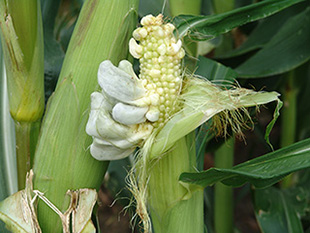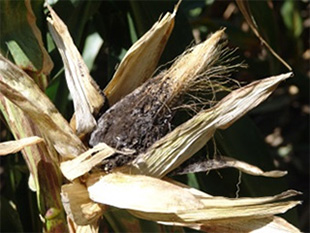G2223
Smut Diseases of Corn
This NebGuide describes the two smut diseases of corn in Nebraska, common smut and head smut, including their symptoms, life cycle, and management.
Tamra A. Jackson-Ziems, Extension Plant Pathologist
- Common Smut
- Symptoms

Figure 1. Two smut diseases occur in corn in Nebraska, common smut (upper left ear) and head smut (bottom ear).
- Epidemiology
- Management
- Huitlacoche
- Symptoms
- Head Smut
Two smut diseases of corn occur in Nebraska (Figure 1). Despite their similar appearance, their disease cycles are very different, as are their yield loss potential and management strategies (Table 1).
Common Smut
The more common of the two diseases is common smut, also known as boil or blister smut because of the galls it produces. It is caused by the fungus Ustilago maydis.
Symptoms
The development of thick, fleshy galls that contain spores is a diagnostic sign of the disease. Galls can develop on any plant part and are especially common on the ears. To some people the galls look like mushrooms (Figure 2). Galls that develop on leaves may appear different than on other plant parts, and often are much smaller and less noticeable than elsewhere on the plant (Figures 3a and 3b). Galls may develop at any point in the season on actively growing plant parts. Initial infections may cause chlorosis of affected parts, as well as rippling on leaves where galls will eventually form. Galls developing on the stalks (Figure 4) are potentially the largest and galls on the roots (Figure 5) are least common.
|
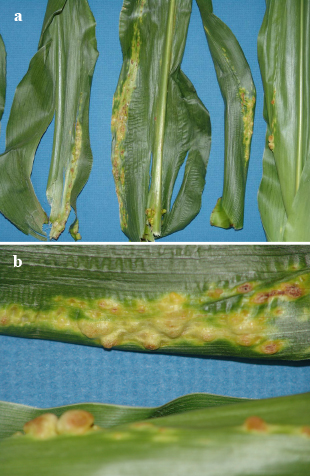 |
|
Figures 3a and 3b. Common smut galls on leaves are often small and look like blisters. |
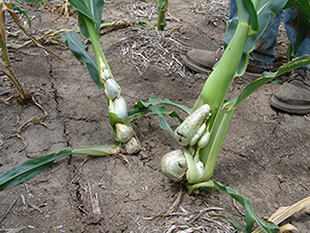 |
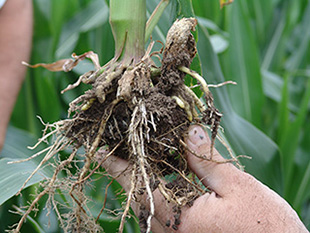 |
|
Figure 4. Galls developing on stalks are often larger than those on other plants parts. |
Figure 5. Galls also may develop underground on the developing roots (top center of photo). |
Epidemiology
The fungus survives for several years in the soil as dark brown to black, thick-walled spiny spores (teliospores). Germinating teliospores produce basidiospores that must fuse with other basidiospores of the opposite mating type to create infection hyphae (growing strands of the fungus). The infection hyphae infect corn plant cells that are growing and still expanding. Recently infected plant tissue may become yellow and begins enlarging almost immediately to eventually produce the characteristic tumor-like galls that are made up of both fungal and plant tissue. Although galls develop most commonly on the ears, they may also develop on the tassels (Figure 6), stalks, leaves, and less frequently on the roots. As the galls enlarge and mature, fungal strands grow throughout the galls, causing development of dark streaks (Figure 7) until the cells finally mature into large quantities of teliospores. The fleshy, soft gall eventually thins and dries, bursting open to reveal dusty black spores inside. The pigment and thick walls of the teliospores enable them to survive harsh conditions and overwinter in the soil.
 |
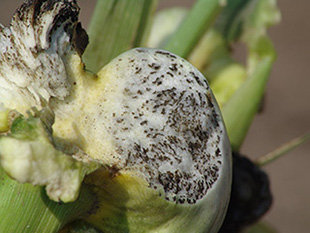 |
|
Figure 6. Common smut galls may develop on tassels. |
Figure 7. Dark streaks may appear inside galls as fungal strands develop into spores. |
Spores may be spread by wind or splashing rain/irrigation water onto plants where they may infect through wounds or silks. Common smut can be found in practically every corn field in the Midwest to some extent, although widespread distribution of the disease and yield loss is not common. Severe weather events that cause plant wounds during the early or middle part of the season while plants are still developing can lead to widespread common smut infection and potential yield losses. In addition, the failure of kernels to become pollinated during hot and/or dry conditions that cause crop stress can lead to increased incidence of common smut galls on ears. Although, like other fungi, the pathogen needs moisture for spore dispersal and germination.
Management
This disease is usually not considered economically important; however, some fields may sustain substantial loss with widespread disease after severe weather events. Unfortunately, there are no management recommendations for common smut in field corn. Field corn hybrids are somewhat less susceptible to the disease compared to sweet corn hybrids. Sweet corn that is grown for the fresh market or canning and becomes diseased with common smut may become unmarketable. If common smut is a consistent problem in sweet corn, switching to a hybrid with more resistance can reduce disease incidence.
Huitlacoche
Since the fungus that causes common smut is closely related to other fungi that produce mushrooms, the smut galls themselves have some of the same characteristics that make them desirable for eating. In Mexico, common smut galls are commonly eaten as a delicacy and referred to as huitlacoche (or sometimes cuitlacoche or Mexican and/or maize truffles). Smutted ears are sold for more than 30 times the value of healthy ears in some Mexican produce markets. In the United States, restaurants now offer some selections on their menus and canned cuitlacoche is available in some popular grocery stores.
Head Smut
Head smut of corn is caused by the fungus Sphacelotheca reiliana (syn. Sporisorium holci-sorghi) and occurs in some fields in Nebraska. Yield loss due to the disease is variable and directly dependent upon disease incidence because infected plants usually don’t produce viable kernels. In addition, the disease can indirectly impact grain value because it is subject to export restrictions to some countries.
Symptoms
Although the fungus causing head smut infects plants systemically, disease is not obvious until symptoms develop on ears and tassels during the middle and end of the season. Infected ears and tassels may be completely replaced with smut sori filled with large quantities of black, dusty teliospores (Figure 8). Although the spores appear similar to those produced by common smut, they are not produced in large, fleshy galls and are only produced on the reproductive plant parts. Infected plants may develop bizarre symptoms on either the ear or the tassel, including the production of wire-like extensions of the vascular bundles in the tassel (Figure 9) or finger-like proliferations in the ear (Figure 10a and 10b). Infected plants may initially be recognized by their teardrop-shaped ears (Figure 11a and 11b) and lack of silks, where the husks are filled with teliospores on the cob. Infected tassels may be substantially shorter than others in the field.
|
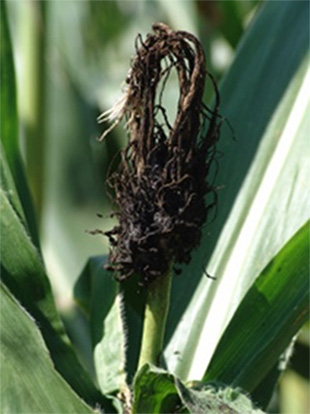 |
|
Figure 9. Infected tassels may produce thick, smutted vascular bundles. |
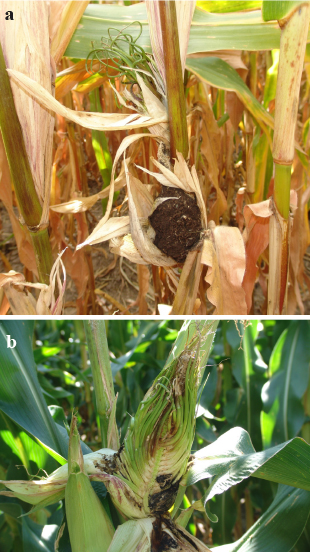 |
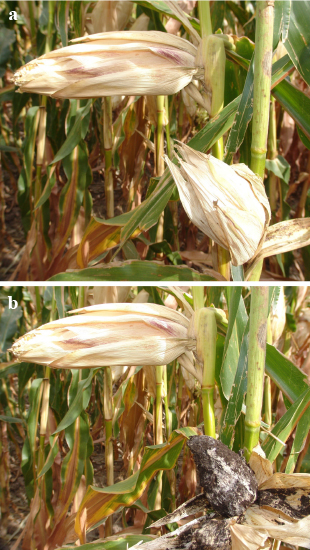 |
|
Figure 10a and 10b. Bizarre growths are often produced in ears infected with the head smut fungus. |
Figure 11a and 11b. Ears with head smut may appear teardrop-shaped (top) and can be husked to reveal spores (bottom). |
Epidemiology
The fungus survives as thick-walled dark brown to black spiny teliospores in the soil for several years, but unlike common smut, the head smut teliospores are not contained within conspicuous fleshy galls. Several races of the fungus are known, indicating a pathogenic specialization to several hosts, including corn, sorghum, Sudan grass, and Johnson grass. Cool and dry weather that delays seedling growth promotes initial infection of seedling roots by the head smut fungus. Warm (70-83°F) and relatively dry soil conditions favor fungal infection as well.
Fungal growth progresses into actively growing meristematic tissue and the seedling plants become systemically infected, though infection is only obvious in flowering plants and later in the mature ears (and less commonly in tassels) with the development of large amounts of teliospores. Infected ears and tassels are usually sterile, and thus yield loss is often directly related to the incidence of the disease. The fungus also can be seedborne, which is not considered to be an important source of infection, but can be a point source for introduction into fields.
Other Factors Affecting Disease Development. Reports indicate disease incidence is higher in nitrogen-deficient soils, but can be decreased with applications of urea, ammonium sulfate, triple superphosphate, and calcium nitrate. Injuring seedling plants in research trials also has increased infection rates.
Management
Hybrids vary in their susceptibility/resistance to the fungus that causes head smut. Since infection occurs in the roots of seedling plants, some systemic seed treatment and in-furrow fungicides can be effective in reducing incidence of head smut. The planting date also may be altered in some areas to reduce disease. Planting rapidly emerging hybrids earlier in cooler soils can be a way to avoid infection since the optimal temperatures for teliospore germination are warmer than those required for corn seed germination.
Table 1. Differences between common and head smut diseases in corn. |
|||||
| Disease | Causal Agent | Spore Production |
Infection | Conditions Favoring Infection | Management |
| Common smut | Ustilago zeae (syn. Ustilago maydis) | In thick, fleshy, mushroom-like galls | Localized | Wounding; plant stress that affects pollination | Field corn: No effective management strategies. Sweet corn: Plant more resistant hybrids. |
| Head smut | Sphacelotheca reiliana (syn. Sporisorium holci-sorghi) | In thin-walled sori that burst early in ear development to release spores | Systemic | Later planted corn; drier and warmer soil temperatures (70-83°F); N deficiency | Apply seed treatment and in-furrow fungicides. Plant earlier in cooler soils. Optimize soil fertility. |
This publication has been peer reviewed.
Visit the University of Nebraska–Lincoln Extension Publications website for more publications.
Index: Plant Diseases
Corn
Issued January 2014
